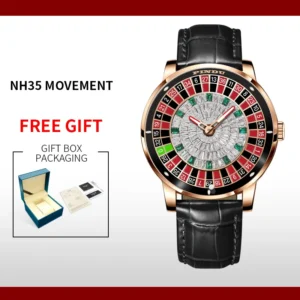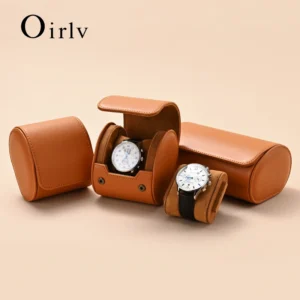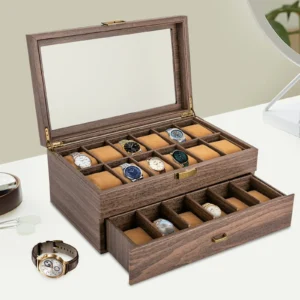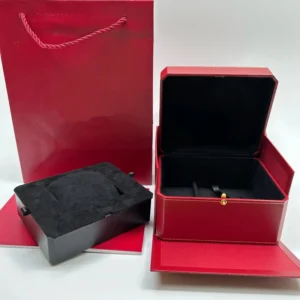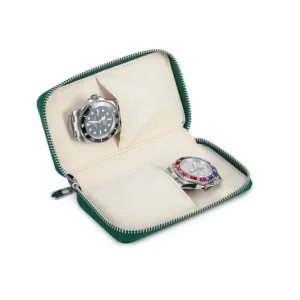Understanding the Importance of Quality Watch Storage
For watch enthusiasts and collectors, proper storage isn’t just about keeping timepieces in one place—it’s about preserving their value, functionality, and beauty. A quality watch organizer provides essential protection against common threats like dust accumulation, scratched crystals, and premature wear on leather straps. Beyond mere protection, these specialized storage solutions enhance your collecting experience by showcasing your timepieces while keeping them accessible for daily selection.
This is particularly crucial for mechanical and automatic watches, which benefit from consistent positioning and protection from magnetic fields and humidity. The right storage solution acts as both a functional tool and a display piece that complements your collection.
Finding the perfect watch organizer requires understanding various features that impact both protection and presentation. Proper watch collection storage planning can significantly extend the life of your timepieces while allowing you to enjoy them even when they’re not on your wrist. In this comprehensive guide, we’ll explore the essential features to consider when selecting a watch organizer that perfectly suits your collection and needs.
Materials and Construction Quality
A. Exterior Materials and Durability
The exterior material of your watch organizer determines not only its appearance but also its durability and protective capabilities. When evaluating options, consider these primary materials and their characteristics:
Wood: Often considered the premium choice, solid woods like walnut, oak, and cherry offer natural beauty and excellent durability. Wooden watch storage options provide superior protection against environmental changes and often age beautifully. Look for solid wood construction rather than thin veneers over MDF (medium-density fiberboard), which may not last as long or provide the same level of protection.
Leather: Genuine leather exteriors offer a luxurious feel and sophisticated appearance. Full-grain leather provides the best durability while retaining natural character, while corrected-grain and bonded leathers are more affordable but less durable. Synthetic leathers offer similar appearances at lower price points but may not age as gracefully.
Carbon Fiber: Modern collections often feature carbon fiber elements, offering exceptional strength-to-weight ratio and contemporary styling. These are particularly suitable for sports watch collections.
Metal: Aluminum and stainless steel organizers provide industrial styling and excellent durability. They’re often heavier but offer superior protection against physical impacts.
Acrylic/Glass: Components made from these materials allow visibility while protecting watches. Quality options use tempered glass or scratch-resistant acrylics.
Quality construction indicators include precision-cut joints, consistent finish application, solid hinges, and overall weight. Watch for even seams, smooth operation of moving parts, and attention to detail in corners and edges—these signify craftsmanship that extends to the protective qualities of the organizer.
Our collection of wooden watch boxes showcases various high-quality options that combine durability with elegant design.
B. Interior Protection Systems
The interior of a watch organizer is arguably even more important than its exterior, as this is what directly contacts your valuable timepieces.
Lining Materials: Premium watch organizers use soft, non-abrasive materials like velvet, suede, or microfiber. These materials prevent scratches on watch cases and bracelets while providing cushioning against minor impacts. Synthetic velvet offers good protection at a lower price point, while genuine suede provides superior softness.
Padding Quality: The density and resilience of interior padding significantly impact protection. Quality organizers use firm yet yielding foam cores beneath the soft lining to absorb shocks without compressing permanently over time.
Moisture and Dust Protection: Superior watch organizers feature precision-engineered closures that create effective seals against dust infiltration. Some premium models incorporate silica gel compartments or humidity regulation systems to control moisture levels.
Removable Components: Quality interiors often feature removable cushions or dividers that allow for cleaning and configuration adjustments. This flexibility ensures your organizer can accommodate different watch styles and sizes over time.
The interior should hold watches securely without placing stress on bracelets or straps. Quality watch pillows provide just enough tension to keep watches in place without stretching or deforming bands, ensuring your collection remains in perfect condition whether stored for days or months.
Organization and Storage Capacity
A. Determining the Right Capacity
Selecting the appropriate size for your watch organizer requires thoughtful consideration of both your current collection and future acquisitions:
Current Collection Assessment: Count your current watches and add 20-30% capacity for future growth. This “collecting room” prevents the need for replacement storage as your collection expands.
Standard Capacity Options:
- Small (2-6 slots): Perfect for casual collectors or travel use
- Medium (8-12 slots): Ideal for enthusiasts with growing collections
Large (15+ slots): Suited for serious collectors with extensive collections
Configuration Considerations: Single-tier organizers offer better visibility but require more surface area, while multi-tier designs maximize vertical space with drawers or levels. For collections featuring both watches and accessories, combination units offer versatility.
Space Efficiency: Consider the organizer’s footprint relative to your available space. Overcrowded storage not only looks cluttered but can lead to watches scratching against each other or their compartment walls.
Effective organizing of your watch collection involves balancing accessibility with protection. For many collectors, a medium-sized 12-watch box provides ideal capacity that accommodates a diverse collection while allowing easy selection for daily wear.
B. Compartment Design and Watch Compatibility
The individual compartments within your watch organizer determine how well your specific timepieces will fit and be protected:
Spacing Between Compartments: Quality organizers provide sufficient separation between watches to prevent contact, typically at least 1-1.5 inches between slots. This spacing ensures watches don’t touch even if slightly shifted.
Cushion Design: Look for cushions that secure watches without stressing components. The ideal cushion compresses slightly when a watch is placed but provides enough resistance to keep the timepiece positioned correctly.
Size Compatibility: Standard cushions typically accommodate watches with cases between 36-42mm, but many collectors own pieces outside this range. Premium organizers feature cushions of varied sizes or adjustable designs that can handle both smaller dress watches and oversized sports models (45mm+).
Bracelet Accommodation: Watches on metal bracelets require different support than those on leather straps. Quality organizers feature cushions designed to work with both closed and deployed bracelets without causing stress to the clasp mechanisms.
Customization Options: Some high-end organizers offer interchangeable cushion systems or adjustable dividers that can be reconfigured as your collection evolves, providing long-term versatility.
The best compartment designs protect each timepiece individually while maintaining the overall organization system of the storage solution.
Security and Display Features
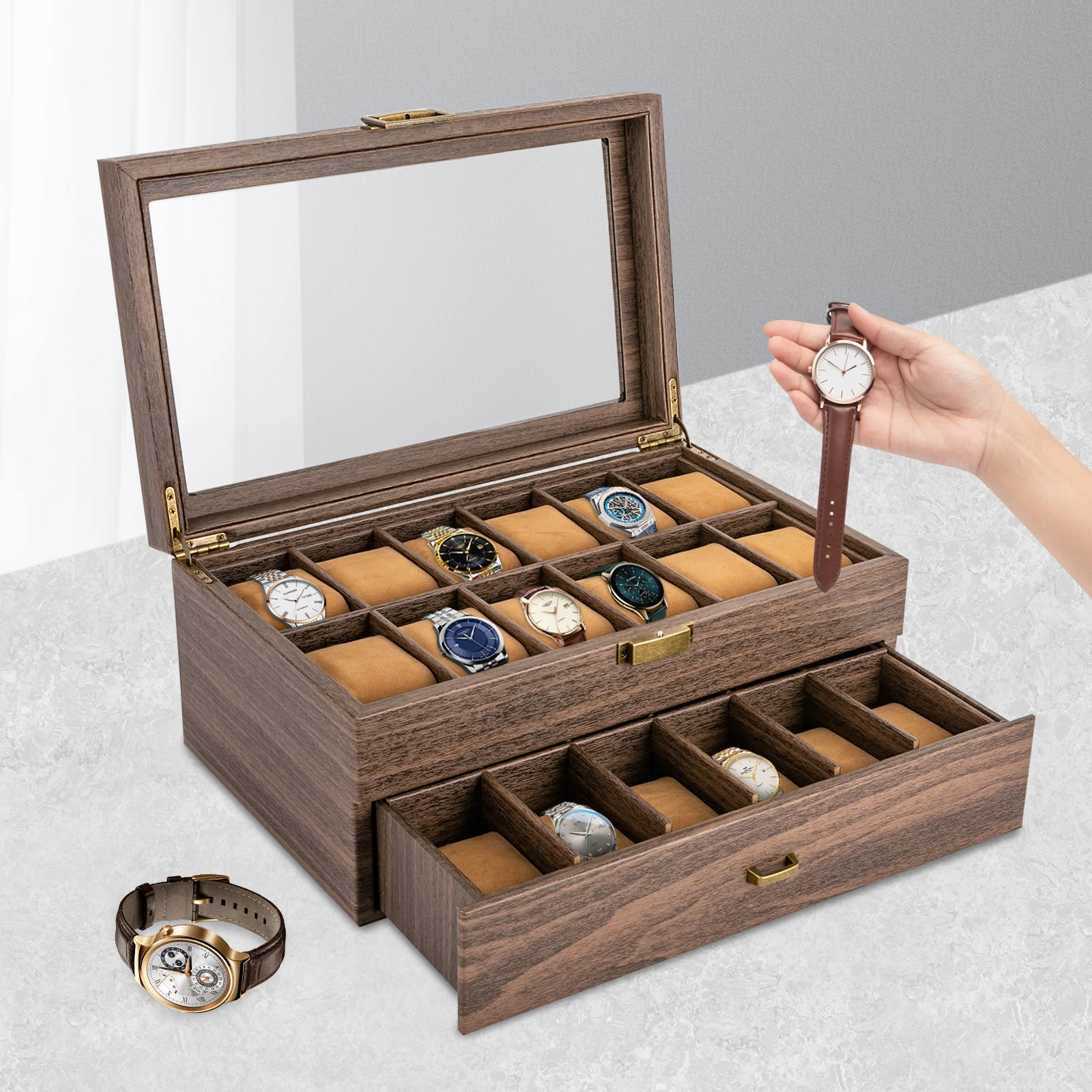
A. Security Mechanisms for Valuable Collections
For collections that represent significant investment, security features are essential considerations:
Key Locks: Traditional lock-and-key systems provide reliable security but require keeping track of small keys. Quality key locks feature solid metal components rather than plastic for durability and security.
Combination Locks: These eliminate the need for keys but require remembering a code. Look for models with at least 3-4 digits for adequate security and smooth-turning dials that won’t stick or wear prematurely.
Magnetic Closures: While not offering true security, quality magnetic clasps provide convenience while keeping lids closed securely enough to prevent accidental opening. Premium versions use powerful neodymium magnets that maintain strength over time.
Snap Locks and Latches: These provide basic security through mechanical closure. Quality options feature metal components rather than plastic for improved durability.
The appropriate level of security depends on both collection value and usage context. For travel purposes, secure watch travel cases with reinforced locks offer protection during transit, while home storage may balance security with convenient access.
Our selection of luxury watch boxes includes various security options that protect valuable timepieces while maintaining elegant aesthetics.
B. Display Visibility and Aesthetics
The display aspect of watch organizers transforms storage from purely functional to part of the collecting experience:
Glass Top Designs: These allow viewing without opening the case, protecting watches from dust while keeping them visible. Quality glass tops use tempered glass that resists scratching and provides clarity.
UV Protection: Premium display cases incorporate UV-resistant glass or acrylic to prevent dial fading and leather deterioration—particularly important for vintage pieces or those with vibrant dials.
Viewing Angles: While flat displays are common, angled displays (typically 15-30 degrees) offer improved visibility when placed on dressers or shelves. Some premium organizers feature adjustable display angles.
Integrated Lighting: High-end display organizers may include LED lighting systems that illuminate the collection, enhancing appreciation of dial details and finishing. Quality lighting systems use neutral white LEDs that don’t generate heat or fade watch components.
Our watch display case collection features options that balance protection with presentation, allowing you to enjoy your timepieces even when they’re not being worn.
Specialized Features for Watch Care
A. Watch Winding Technology
For collectors of automatic watches, winding features represent a critical functional element in storage solutions:
TPD (Turns Per Day) Adjustability: Quality winders offer multiple settings (typically 650-1,800 TPD) to match different watch movement requirements. This prevents both under-winding (which leads to inaccuracy) and over-winding (which can stress movements).
Rotation Direction Options: Premium winders provide clockwise, counterclockwise, and bidirectional settings to accommodate various movement designs. This customization ensures proper winding regardless of the specific automatic mechanism.
Motor Quality: Superior winders use Japanese or Swiss motors known for quiet operation and longevity. These motors maintain consistent rotation speeds without loud humming or mechanical noise.
Power Options: While most winders use AC adapters, quality models often include battery backup or can operate on batteries alone for flexibility in placement. Look for energy-efficient designs that minimize power consumption.
Understanding proper watch winder TPD settings is essential for maintaining automatic watches in perfect running condition. Our collection of automatic watch winders includes options with precise control systems suited for various movement types.
B. Additional Storage Compartments
Comprehensive watch organizers often include additional compartments that enhance their utility:
Strap and Bracelet Storage: Dedicated slots for extra straps allow collectors to keep alternative options organized and unwrinkled. Quality compartments prevent leather straps from developing permanent bends.
Tool Storage: Small sections designed for spring bar tools, screwdrivers, and polishing cloths keep maintenance supplies accessible alongside the watches themselves.
Parts Organization: Tiny compartments for spare links, pins, and other small components prevent these easily lost items from disappearing.
Drawer Systems: Pull-out drawers beneath main watch compartments maximize storage efficiency. Quality drawers feature smooth glides and soft-close mechanisms that prevent jarring movements.
Jewelry Integration: Many organizers include sections for rings, cufflinks, or other accessories, creating a complete storage solution for personal items.
These supplementary features transform a simple watch box into a comprehensive collection management system.
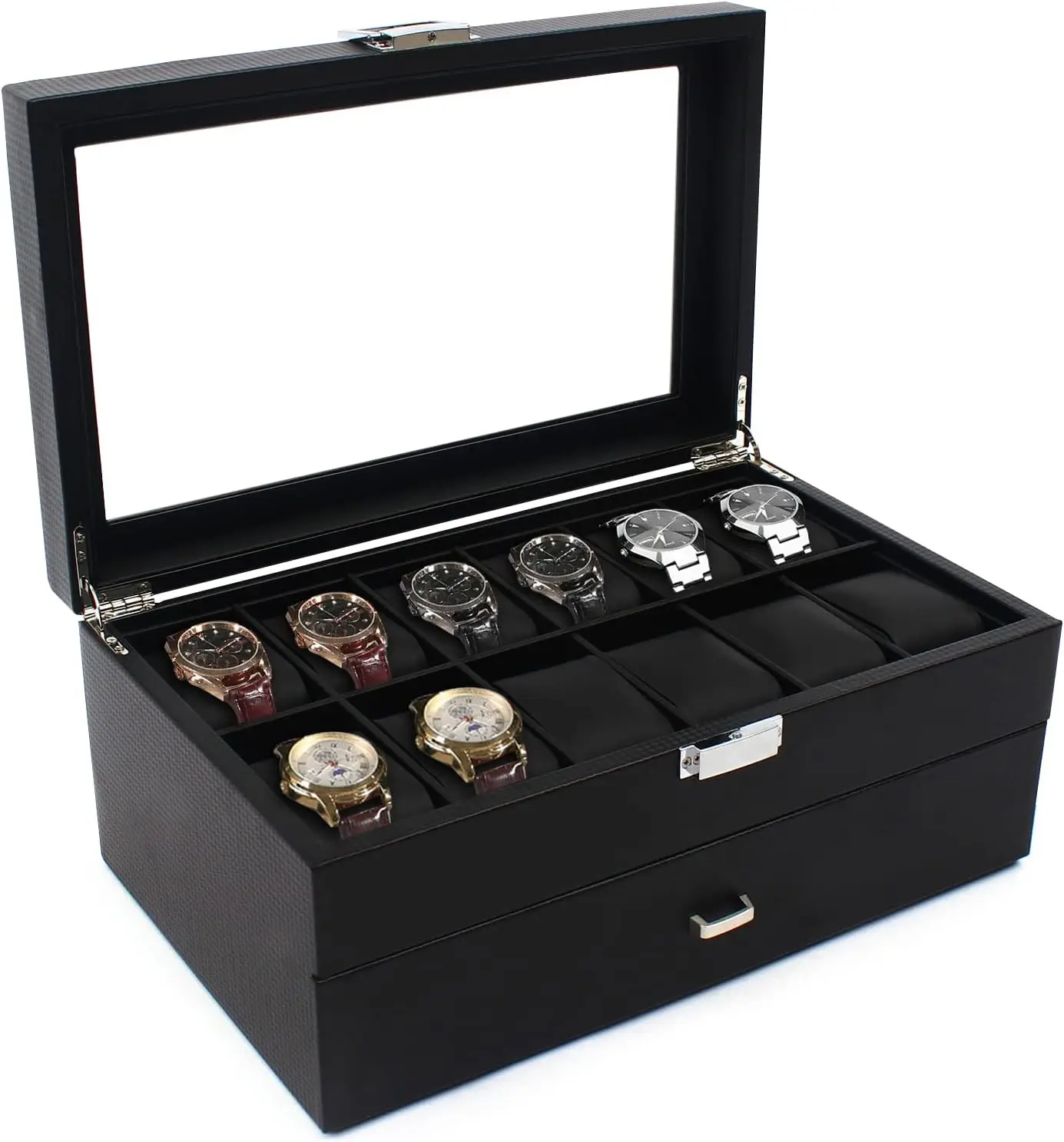
Portability and Travel Considerations
For collectors who travel with timepieces, specialized portable solutions offer crucial protection:
Impact Resistance: Travel organizers require enhanced shock absorption through reinforced exteriors and additional internal padding. Quality options use rigid frames with softer protective layers.
Size Considerations: Travel cases must balance protection with practicality. Look for compact dimensions (typically under 10” x 6” x 3” for 2-4 watch cases) that fit easily in carry-on luggage.
Security Features: Travel-specific organizers should include secure closures that cannot accidentally open during transit. Zippered cases should use heavy-duty, smooth-operating zippers with locking features.
Material Differences: While leather and wood dominate home storage, travel cases often utilize lightweight but strong materials like aluminum, polycarbonate, or ballistic nylon that offer superior impact protection.
Waterproofing: Quality travel organizers provide water resistance through sealed closures and water-repellent materials, protecting watches from unexpected exposure to moisture.
The differences between watch boxes and watch rolls highlight various approaches to portable storage. Our selection of watch travel cases includes options designed specifically for the challenges of on-the-go protection.
Aesthetic Design and Home Integration
Watch organizers often serve as display pieces in addition to their functional role, making their design aesthetic an important consideration:
Style Compatibility: Consider whether the organizer complements your home’s interior design. Options range from traditional (mahogany, walnut finishes with classic hardware) to contemporary (minimalist designs with clean lines and modern materials).
Color Coordination: Quality organizers are available in various finishes and colors to match existing furniture. Consider whether the piece will stand alone or blend with surrounding decor.
Display Location: The intended placement affects size and design requirements. Dresser-top organizers might prioritize a smaller footprint, while dedicated display pieces for shelving can be larger and more showcase-oriented.
Personalization Options: Premium organizers may offer customization through monogramming, custom hardware, or bespoke interior configurations that reflect personal taste.
Thoughtful integration of watch storage in bedroom or living room spaces enhances both the protection of your timepieces and the aesthetic appeal of your home environment.
Environmental Factors and Watch Preservation
Beyond physical protection, quality watch organizers address environmental conditions that affect timepiece longevity:
Humidity Control: Mechanical watches function best in stable humidity between 45-60%. Premium organizers may incorporate hygrometers or humidity-regulating materials to maintain optimal conditions.
Temperature Stability: Watch lubricants and movement accuracy are affected by temperature fluctuations. Quality wood and leather organizers naturally buffer against rapid temperature changes better than metal or plastic alternatives.
Light Protection: Ultraviolet light can fade dials and degrade leather straps over time. Solid-lid designs or UV-filtered glass tops prevent this damage during storage.
Air Circulation: Some premium organizers feature subtle ventilation designs that allow minimal air exchange while preventing dust infiltration, reducing the risk of condensation or stagnant air pockets.
For collections that include vintage or particularly valuable pieces, understanding long-term watch storage protection techniques can significantly preserve both function and value.
Investment Value and Price Considerations
When selecting a watch organizer, matching quality to collection value ensures appropriate protection without unnecessary expense:
Budget Options ($30-100): These typically feature synthetic materials, basic cushions, and minimal security features. They provide organizational benefits but limited protection for valuable pieces.
Mid-Range Options ($100-300): These offer solid construction, quality materials, and good protection suitable for most collectors. Features like glass tops, better cushioning, and basic security mechanisms appear at this level.
Premium Options ($300-1000+): High-end organizers use superior materials, craftsmanship, and protective features. These include precision-engineered winding mechanisms, advanced humidity control, and sophisticated security systems.
The value proposition should align with your collection’s worth—investing 5-10% of your collection’s value in storage typically represents a reasonable protection investment. For those with budget constraints, budget-friendly watch storage options can provide essential protection while remaining affordable.
Luxury Watch Boxes, Men's Watch Boxes, Single Watch Box
Price range: $903.35 through $980.97 Select options This product has multiple variants. The options may be chosen on the product pageSingle Watch Travel Case, Watch and Jewelry Box, Watch Roll Travel Case
Price range: $93.44 through $140.65 Select options This product has multiple variants. The options may be chosen on the product pageMen's Watch Organizer, Watch Display Case, Watch Organizer
Price range: $112.68 through $169.45 Select options This product has multiple variants. The options may be chosen on the product pageAutomatic Watch Winder, Luxury Watch Winder, Single Watch Box
$307.39 Select options This product has multiple variants. The options may be chosen on the product pageLuxury Watch Boxes, Luxury Watch Travel Case
Price range: $200.33 through $224.57 Select options This product has multiple variants. The options may be chosen on the product pageLeather Watch Travel Case, Men's Watch Travel Case, Watch Roll Travel Case
Price range: $91.37 through $92.63 Select options This product has multiple variants. The options may be chosen on the product page
Making the Final Selection: Decision Framework
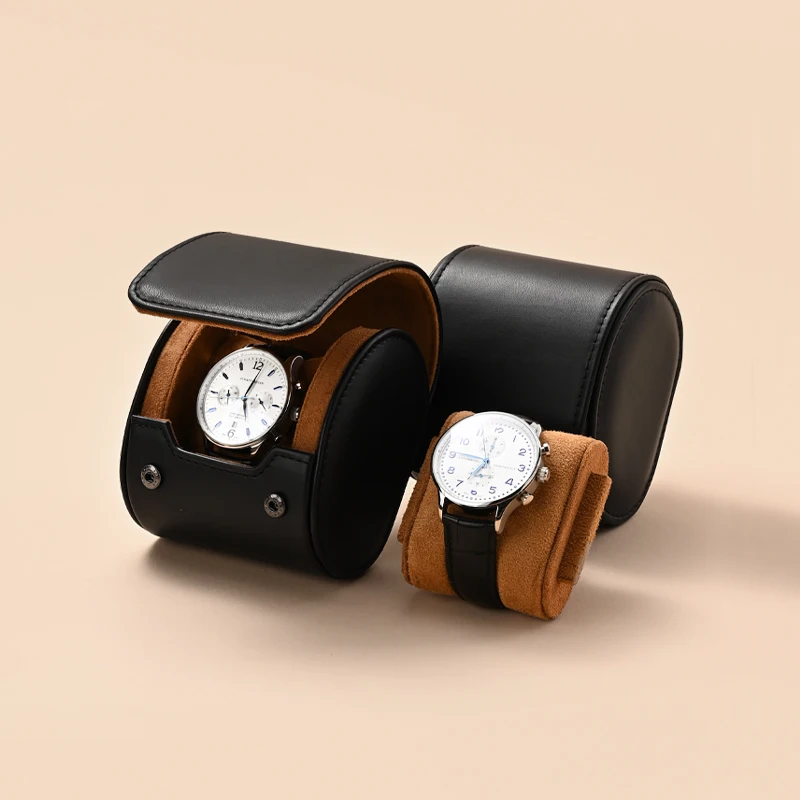
When making your final selection, this structured approach helps ensure you choose the right watch organizer:
Essential Assessment Checklist:
Collection Size and Growth:
– How many watches do you currently own?
– How many do you anticipate adding within the next year?
– Do you have oversized or uniquely shaped watches requiring special accommodation?Primary Purpose:
– Is daily watch selection your priority (display-focused)?
– Is long-term protection more important (security-focused)?
– Do you travel frequently with multiple watches (portability-focused)?Watch Types and Special Requirements:
– What percentage of your collection is automatic vs. quartz?
– Do you have watches with special material sensitivities (vintage pieces, precious metals)?
– Are there size extremes in your collection that require custom fit solutions?Environment and Placement:
– Where will the organizer be kept (bedroom, office, display cabinet)?
– Is the environment subject to humidity or temperature fluctuations?
– How much physical space is available for the organizer?Budget Allocation:
– What is the total value of your watch collection?
– What percentage of that value are you willing to invest in storage?
– Which features provide the most value for your specific needs?
For comprehensive guidance on selecting between styles, our guide on comparing types of watch storage provides detailed analysis. When ready to make a selection, our ultimate guide to choosing watch holders and organizers walks through the decision process step by step.
Advanced Watch Storage Solutions
For serious collectors with extensive or particularly valuable collections, specialized solutions offer enhanced protection and organization:
Custom Cabinetry: Bespoke watch cabinets can be designed to match existing furniture while providing security features like concealed compartments or integrated safes.
Multi-Function Systems: Advanced storage may combine display cases with built-in winders, lighting systems, and climate control in furniture-quality cabinetry.
Security Integration: For high-value collections, watch storage can be integrated with home security systems, including motion sensors, remote monitoring, or biometric access controls.
Collection Management: Digital inventory systems using RFID or barcode scanning can track wear time, maintenance schedules, and insurance documentation while complementing physical storage.
Climate Management: Beyond basic humidity control, advanced systems maintain precise temperature and humidity levels with active monitoring and adjustment capabilities.
These luxury watch storage setups represent the pinnacle of collection protection and organization for those with substantial investments in fine timepieces.
Frequently Asked Questions
How often should automatic watches be wound when stored?
Automatic watches not in regular rotation benefit from being fully wound once every 3-4 weeks to keep lubricants distributed throughout the movement. Quality watch winders can maintain this schedule automatically with appropriate TPD settings.
Can different watch brands be stored together safely?
Yes, most watches can be stored together, but certain precautions help: maintain spacing between watches to prevent contact; keep highly magnetic watches (like some tool watches) separated from vintage pieces; and ensure each watch has appropriately sized cushions or holders.
How should I clean and maintain my watch organizer?
Wood exteriors benefit from occasional polishing with appropriate wood care products. Interior fabrics can be gently vacuumed with a soft brush attachment. Remove cushions when possible for more thorough cleaning. Avoid liquid cleaners on interior surfaces that might transfer to watches.
Are watch winders harmful to automatic watches?
Quality winders with appropriate settings are not harmful and can benefit automatic watches by maintaining lubrication distribution. However, poor-quality winders with improper settings or excessive vibration may potentially cause premature wear.
Can smartwatches be stored in traditional watch organizers?
Yes, but with considerations: ensure the compartment accommodates thicker cases typical of smartwatches; provide access for charging cables if needed; and consider separate storage if frequent charging makes regular removal necessary.
For more innovative approaches to organizing diverse collections, explore our guide to watch storage ideas for collectors that addresses these common challenges.


